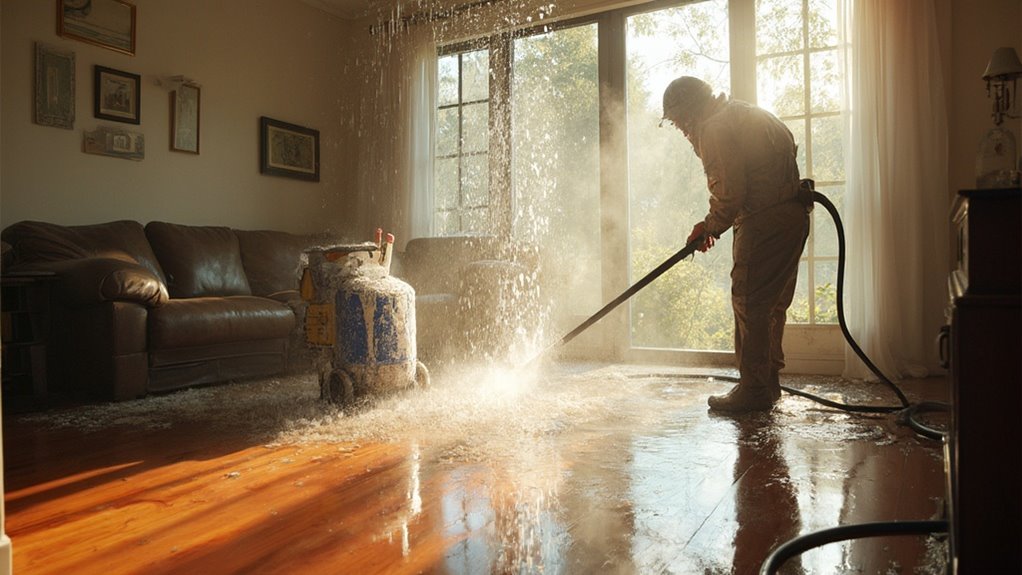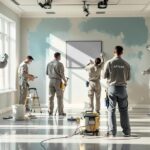When dealing with water damage, you need a thorough strategy, and Care Pro in Smyrna, GA, offers just that. First, they perform an initial inspection to assess the damage and identify the source. Next, they contain the area to prevent further issues, using pumps and dehumidifiers to mitigate water exposure. Effective water extraction follows, utilizing industrial equipment to eliminate moisture. After that, damaged surfaces are removed for proper cleanup. Finally, they conduct repairs and reconstruction, ensuring long-term solutions. To understand all the steps involved in this meticulous process, you'll find valuable insights ahead.
Key Takeaways
- Care Pro in Smyrna, GA offers comprehensive water damage restoration services, including initial inspection and assessment to identify the source of water intrusion.
- They utilize advanced moisture detection methods, like thermal imaging, to document damage and plan effective restoration strategies.
- The team isolates affected areas and employs pumps and dehumidifiers to stop water flow and mitigate further damage.
- High-capacity water extraction and drying equipment are used to efficiently remove water and reduce moisture levels in the environment.
- Care Pro ensures thorough repairs and reconstruction, assessing structural integrity and replacing damaged materials for long-term protection against water issues.
Initial Inspection and Assessment

When tackling water damage, the first step is conducting a detailed initial inspection and assessment of the affected area. Start with visual inspection techniques to identify visible signs of damage, such as stains, discoloration, and mold growth. It's vital to determine the water source—be it leaks, flooding, or burst pipes—as this will inform your remediation strategy. Look for structural irregularities like peeling paint and warped flooring, which indicate deeper issues.
Next, employ advanced moisture detection methods to assess moisture levels accurately. Utilize moisture meters to gauge the moisture content in materials like drywall and wood. Thermal imaging cameras can reveal hidden moisture behind walls or under floors, while hygrometers measure the air's relative humidity. Probing devices allow you to evaluate moisture levels beneath surfaces without causing damage. An effective water damage assessment is essential for developing a comprehensive restoration plan. Additionally, a thorough assessment is crucial for guiding the water removal services that will follow.
Document all findings meticulously, capturing photographs and detailed notes. This documentation not only aids in creating a thorough restoration plan but is also significant evidence for insurance claims. By mastering these inspection and assessment techniques, you lay the groundwork for effective remediation and restoration of the affected area.
Containment and Mitigation
Once you've completed the initial inspection and assessment, the next step involves containment and mitigation to effectively manage water damage. Implementing proper containment strategies is essential to isolate and secure the affected area, preventing the further spread of water and contaminants. Utilize specialized equipment like plastic sheeting and sandbags to create barriers, while industrial fans help control humidity levels, inhibiting mold growth.
To guarantee effective containment and mitigation, focus on these key actions:
- Isolate the Affected Area: Secure the impacted zone to minimize exposure to occupants and prevent cross-contamination.
- Stop Water Flow: Employ pumps and dehumidifiers to halt water infiltration and mitigate damage.
- Remove Damaged Materials: Safely dispose of soaked carpets and warped floorboards to reduce health risks and streamline the restoration process. Additionally, it is crucial to understand that water damage categories play a significant role in determining the best mitigation strategies.
Water Extraction and Drying

Effective water extraction and drying are vital steps in the restoration process, greatly reducing the risk of long-term damage and mold growth. To achieve the best results, you'll utilize high-capacity pumps and wet vacuums, guaranteeing you remove the majority of the water quickly. Remember, physical water extraction is at least 500 times more efficient than relying solely on dehumidifiers and air movers.
Once water extraction is complete, focus on advanced drying techniques. Deploy dehumidifiers to remove excess moisture from both the air and affected materials. Desiccant dehumidifiers, in particular, are effective in challenging conditions, preventing secondary issues like mold growth.
Enhancing air circulation is just as vital; position industrial-strength air movers to expedite evaporation from surfaces. Maintaining an ideal temperature accelerates drying, so consider using heaters to warm the affected area. Utilize moisture meters and monitoring tools to track progress, allowing you to make real-time adjustments to your drying plan. Combining these methods guarantees a swift, efficient drying process, setting the stage for successful restoration while safeguarding your property from potential hazards.
Removal of Damaged Surfaces
In the aftermath of water damage, promptly addressing the removal of damaged surfaces is crucial for a successful restoration. This process involves careful assessment and execution to prevent further complications, such as mold growth. Start by identifying and marking areas with damaged drywall and flooring materials.
Here are three critical steps to evaluate:
- Remove Damaged Drywall: Cut away sections of drywall that remain wet or compromised. Use protective gear to shield yourself from harmful contaminants and guarantee safe disposal according to local regulations.
- Assess Flooring Materials: Evaluate carpets, hardwood, and tiles for water damage. Remove any flooring materials that are beyond repair. Thoroughly dry subfloors to mitigate future mold risks.
- Inspect and Clean: After removing damaged surfaces, inspect the area for hidden moisture or damage. Clean and disinfect the space before installing new drywall and flooring materials.
Repairs and Reconstruction

After addressing the removal of damaged surfaces, you need to focus on repairs and reconstruction to restore your property effectively. Start by evaluating the structural integrity of your ceilings, walls, and floors. Identify any damage that requires replacement, such as drywall or shingles, and make sure that you're using appropriate sealants to prevent future water intrusion. Reinforce any weakened areas to avert potential collapse.
For flooring restoration, inspect all surfaces for water damage. Determine if deep cleaning is feasible or if replacement is necessary. If you find that carpet padding is unsalvageable, replace it, and consider using waterproof materials like tile or high-end vinyl for new installations. If you have wooden floors, refinishing them can restore their original condition, but guarantee proper drying and dehumidification to prevent mold growth.
Don't overlook electrical and plumbing components. Replace any damaged elements and ensure all systems meet safety standards. Finally, seal and caulk new materials, apply a fresh coat of paint for added protection, and conduct a thorough final inspection to confirm that everything is dry and secure. This meticulous approach will safeguard your property against future water damage.
Conclusion
To summarize, tackling water damage isn't just a task; it's a race against time. With Care Pro in Smyrna, GA, you're not just getting a service; you're gaining a partner dedicated to restoring your space to its former glory. By following the outlined steps—inspection, containment, extraction, removal, and reconstruction—you guarantee a thorough recovery. Don't let water damage linger; take action now and safeguard your home with the expertise you deserve.





